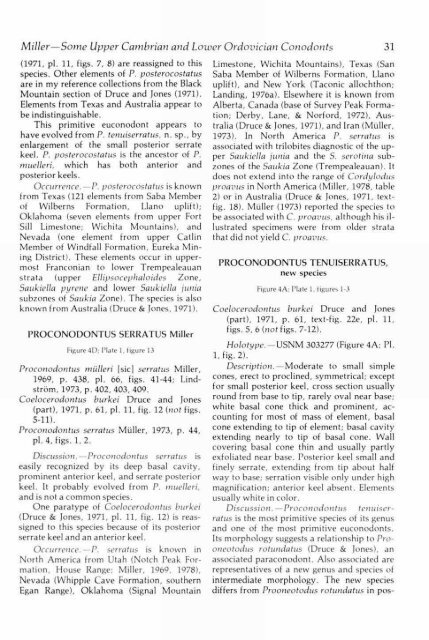View - KU ScholarWorks - University of Kansas
View - KU ScholarWorks - University of Kansas
View - KU ScholarWorks - University of Kansas
You also want an ePaper? Increase the reach of your titles
YUMPU automatically turns print PDFs into web optimized ePapers that Google loves.
Miller-Some Upper Cambrian and Lower Ordovician Conodonts 31<br />
(1971, pl. 11, figs. 7, 8) are reassigned to this<br />
species. Other elements <strong>of</strong> P. posterocostatus<br />
are in my reference collections from the Black<br />
Mountain section <strong>of</strong> Druce and Jones (1971).<br />
Elements from Texas and Australia appear to<br />
be indistinguishable.<br />
This primitive euconodont appears to<br />
have evolved from P. tenuiserratus, n. sp., by<br />
enlargement <strong>of</strong> the small posterior serrate<br />
keel. P. posterocostatus is the ancestor <strong>of</strong> P.<br />
muelleri, which has both anterior and<br />
posterior keels.<br />
Occurrence. - P. posterocostatus is known<br />
from Texas (121 elements from Saba Member<br />
<strong>of</strong> Wilberns Formation, Llano uplift);<br />
Oklahoma (seven elements from upper Fort<br />
Sill Limestone; Wichita Mountains), and<br />
Nevada (one element from upper Catlin<br />
Member <strong>of</strong> Windfall Formation, Eureka Mining<br />
District). These elements occur in uppermost<br />
Franconian to lower Trempealeauan<br />
strata (upper Ellipsocephaloides Zone,<br />
Saukiella pyretic, and lower Saukiella junia<br />
subzones <strong>of</strong> Saukia Zone). The species is also<br />
known from Australia (Druce & Jones, 1971).<br />
PROCONODONTUS SERRATUS Miller<br />
Figure 4D; Plate 1, figure 13<br />
Proconodontus [sic] serratus Miller,<br />
1969, p. 438, pl. 66, figs. 41-44; Lindstrom,<br />
1973, p. 402, 403, 409.<br />
Coelocerodon tus burkei Druce and Jones<br />
(part), 1971, p. 61, pl. 11, fig. 12 (not figs.<br />
5-11).<br />
Proconodontus serratus Iler, 1973, p. 44,<br />
pl. 4, figs. 1, 2.<br />
Discussion.-Proconodontus serratus is<br />
easily recognized by its deep basal cavity,<br />
prominent anterior keel, and serrate posterior<br />
keel. It probably evolved from P. muelleri,<br />
and is not a common species.<br />
One paratype <strong>of</strong> Coelocerodon tus burkei<br />
(Druce & Jones, 1971, pl. 11, fig. 12) is reassigned<br />
to this species because <strong>of</strong> its posterior<br />
serrate keel and an anterior keel.<br />
Occurrence. - P. serratus is known in<br />
North America from Utah (Notch Peak Formation,<br />
House Range; Miller, 1969, 1978),<br />
Nevada (Whipple Cave Formation, southern<br />
Egan Range), Oklahoma (Signal Mountain<br />
Limestone, Wichita Mountains), Texas (San<br />
Saba Member <strong>of</strong> Wilberns Formation, Llano<br />
uplift), and New York (Taconic allochthon;<br />
Landing, 1976a). Elsewhere it is known from<br />
Alberta, Canada (base <strong>of</strong> Survey Peak Formation;<br />
Derby, Lane, & Norford, 1972), Australia<br />
(Druce & Jones, 1971), and Iran (Müller,<br />
1973). In North America P. serratus is<br />
associated with trilobites diagnostic <strong>of</strong> the upper<br />
Saukiella junia and the S. serotina subzones<br />
<strong>of</strong> the Saukia Zone (Trempealeauan). It<br />
does not extend into the range <strong>of</strong> Cordylodus<br />
proavus in North America (Miller, 1978, table<br />
2) or in Australia (Druce & Jones, 1971, textfig.<br />
18). Müller (1973) reported the species to<br />
be associated with C. proavus, although his illustrated<br />
specimens were from older strata<br />
that did not yield C. proavus.<br />
PROCONODONTUS TENUISERRATUS,<br />
new species<br />
Figure 4A; Mate 1, figures 1-3<br />
Coelocerodon tus burkei Druce and Jones<br />
(part), 1971, p. 61, text-fig. 22e, pl. 11,<br />
figs. 5, 6 (not figs. 7-12).<br />
Holotype. -USNM 303277 (Figure 4A; Pl.<br />
1, fig. 2).<br />
Description. -Moderate to small simple<br />
cones, erect to proclined, symmetrical; except<br />
for small posterior keel, cross section usually<br />
round from base to tip, rarely oval near base;<br />
white basal cone thick and prominent, accounting<br />
for most <strong>of</strong> mass <strong>of</strong> element, basal<br />
cone extending to tip <strong>of</strong> element; basal cavity<br />
extending nearly to tip <strong>of</strong> basal cone. Wall<br />
covering basal cone thin and usually partly<br />
exfoliated near base. Posterior keel small and<br />
finely serrate, extending from tip about half<br />
way to base; serration visible only under high<br />
magnification; anterior keel absent. Elements<br />
usually white in color.<br />
Discussion. - Proconodontus tenuiserratus<br />
is the most primitive species <strong>of</strong> its genus<br />
and one <strong>of</strong> the most primitive euconodonts.<br />
Its morphology suggests a relationship to Prooneotodus<br />
rotundatus (Druce & Jones), an<br />
associated paraconodont. Also associated are<br />
representatives <strong>of</strong> a new genus and species <strong>of</strong><br />
intermediate morphology. The new species<br />
differs from Prooneotodus rotundatus in pos-
















